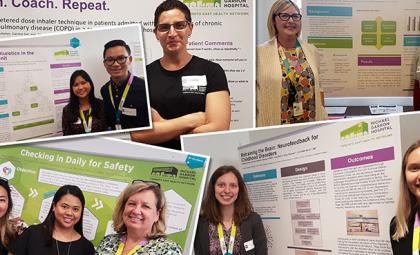MGH opens its doors to innovation

ANNUAL RESEARCH, INNOVATION & EDUCATION SCHOLARSHIP FAIR CENTRES AROUND COMMUNITY
Monday, July 23, 2018 – Michelle Holden
“To affect real change in the community we serve it’s vital we focus on the community right here – in this hospital,” said Sarah Downey. As President and CEO of Michael Garron Hospital (MGH), Downey opened MGH’s 8th annual Research, Innovation & Education Scholarship Fair on June 13.
Each year the event succeeds at elevating the MGH staff community by showcasing a few of the innovative projects on the go at the hospital. Some projects have a basic health need at their core, while others are derived from social elements like communication gaps between patients and providers. What they all have in common is that they start with an idea, one with the patient at the centre.
“Big changes can start from small ideas,” said Mari Iromoto, Director of Quality, Patient Safety, Risk, Privacy, Operational Excellence, Research & Innovation at MGH. With a portfolio as diverse as Iromoto’s, it’s no wonder it’s her team that takes on the challenge of organizing the fair each year.
HIROC is a sponsor of this annual event because of its emphasis on community and its clear link with our vision of partnering to create the safest healthcare system. For the second year in a row, I sat on a panel of judges tasked with determining the top three winners. As someone without a medical background, getting to the heart of these complex projects can be intimidating. However, as MGH’s Communications Coordinator, Diana Hooper explained to me, “A part of what we want the presenters to be able to do is to explain how, at the core, their projects affect the community and strengthen the system.”
What I discovered was that there truly are some amazing projects on the go at MGH – some of which are being done in partnership with other organizations like University Health Network, Sunnybrook, and various community groups.
THE HIGHLIGHTS
Improving Healthcare Worker Adherence to Additional Precautions Using Human Factor Design – This study is all about preventing the transmission of infections to staff, visitors and patients. During the pre-study, the team found that when treating patients with transmissible infections, staff often picked the wrong Personal Protective Equipment (PPE) or didn’t understand the complicated signage telling them which processes to follow. To change this, the project team partnered with a team at Sunnybrook – who was undergoing a similar trial – and a team of Human Factors Engineers to try and improve the system; MGH staff were also consulted. The result is a series of new signs and instructions for when a patient has been admitted with certain infections or illnesses. Being entirely based on visuals, there is little room for confusion. An example of a change to the PPE is that they stopped using goggles, which staff often lost, and created a new disposable face mask to be made available where, and when, staff need to use it. What stood out about this project was that it was truly about making things easier for staff and ultimately contributing to safer outcomes for everyone in the hospital.
Daily Safety Checks at MGH – How do we get leaders together today to understand the risks? The Daily Safety Check was born out of this question and has evolved into a 10-minute daily teleconference where senior leaders meet to discuss current safety issues and find a solution. Issues that are raised at the meeting must have an identified solution by 4 p.m. the same day, and must be resolved within 24 hours. “The magical part of it is that it’s the frontline staff who are asking to bring these issues forward,” said Carolelina San Jose, Quality Specialist at MGH. What happens at these safety checks gets cycled back down through team huddles across the hospital. Iromoto and her team at MGH say that these safety checks are now a part of the routine and the culture – they’ve become a priority.
Exploring Caregiver Knowledge and Attitudes Towards Deprescribing Antipsychotics in Dementia –Almost all of us have experience with a relative or friend suffering from dementia but we don’t all have a solid understanding of the types of medications – specifically antipsychotics – being prescribed to these patients. This project team decided to use the hospitalization of dementia patients as a chance assess the awareness and knowledge of caregivers around antipsychotics. What they found is that the caregivers often believe these medications are safe and effective. “These medications hold a special place for families,” said Dr. Christopher Smith; “but antipsychotics actually have a black box warning and should not be used for dementia,” said Smith. The goal behind the study was to assess and educate caregivers about these medications and use it as a possible first step to deprescribing. Throughout the process they also assessed caregivers’ knowledge, as well as that of staff, around alternative dementia support like music therapy. Ultimately this study is all about helping reduce the potentially harmful and unnecessary medications that our families and friends are taking – it puts the patient at the centre.
While all very different, what each and every project on display at the Research, Innovation & Education Scholarship Fair had in common is that the work will continue long after the fair. Innovation may be sparked by one conversation or thought, but the real magic comes from strengthening and sustaining the idea as a community – something MGH is no stranger to.
Michelle Holden is Communications and Marketing Specialist, HIROC